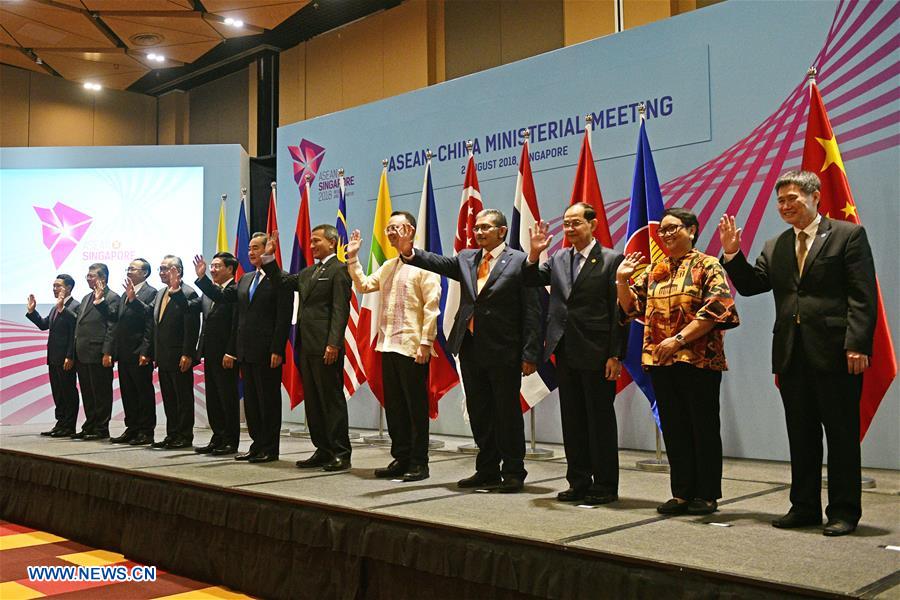Future of China-ASEAN relations
- By Sajjad Malik
 0 Comment(s)
0 Comment(s) Print
Print E-mail China.org.cn, August 14, 2018
E-mail China.org.cn, August 14, 2018

China and the Association of Southeast Asian Nations (ASEAN) are celebrating the 15th anniversary of their strategic partnership, created in 2003 to reflect a realization of the long-term potential of their ties.
ASEAN was established in 1967 and subsequently expanded to encompass 10 members – Brunei, Cambodia, Indonesia, Laos, Malaysia, Myanmar, the Philippines, Singapore, Thailand and Vietnam. It's one of the most vibrant regional organizations surviving various vicissitudes and flourishing over the decades.
China being a close neighbor of almost all the ASEAN members has always attached special importance to its relations with ASEAN and tried to cultivate cooperation in multiple fields as a model of global geo-strategic politics as well as friendship.
Having robust diplomatic ties with ASEAN, as a group as well as with all the individual members, is, therefore, the avowed policy of China. And this was reiterated by Chinese State Councilor and Foreign Minister Wang Yi when he attended the China-ASEAN foreign ministers' meeting last week in Singapore.
Wang called for building a closer China-ASEAN community with a shared future based on mutual respect, as well as increasing cooperation in non-traditional fields like disaster prevention, relief and humanitarian assistance.
"We will share opportunities and face challenges together, so as to build a closer community with a shared future," he said.
There are two strands of this relationship, and equal focus on both is essential in moving forward. The first part relates to Sino-ASEAN trade and economic ties. The two sides face the challenge how to increase their economic cooperation and keep up the trajectory of such booming ties.
It's not just about good statistics linked with investment capital or money earned through export-import channels. There needs to be put in place an effective institutional framework for developing clear long-term policy implications for all.
Xinhua news agency reported that the ASEAN countries had agreed to an early conclusion this year of the Regional Comprehensive Economic Partnership, a free trade agreement (FTA) scheme of the 10 member states and its FTA partners, namely China, Australia, India, Japan, South Korea and New Zealand.
China also wants to upgrade the China-ASEAN cooperation framework from 2+7 to 3+X as part of vision to deepen the strategic partnership.
According to Xinhua, "2+7" refers to a cooperation framework proposed by China in 2013, which emphasizes a two-point political consensus – enhancing strategic trust and promoting economic cooperation – and seven cooperation fields including trade facilitation, inter-connectivity and security exchanges.
It says that the 3+X, using the alphabetical letter "X" adopted in mathematical formulae to represent the unknown, means China-ASEAN will touch upon many fields while focusing on three pillars – political security, economy and trade, and people-to-people exchange.
The second strand of China-ASEAN ties is related to the resolution of disputes through peaceful means and without any foreign intervention. It's encouraging that the two sides realize a durable solution to their bilateral and regional problems can only be explored through mutual dialogue based on goodwill and respect for each other's sensitivities.
The recent agreement at the China-ASEAN foreign ministers' meeting in Singapore on a single draft negotiating text of the Code of Conduct (COC) in the South China Sea is a milestone towards peaceful resolution of issues. The COC will help to stabilize the situation in the South China Sea and open up new avenues for cooperation.
Issues related to the various territorial claims of countries abutting the South China Sea issue were exploited in the past by certain groups and countries for their vested interest. It is heartening to note that China and ASEAN are showing great resolve and readiness to seek a lasting solution.
Peaceful relations between China and ASEAN will not just stabilize the bilateral ties but also greatly contribute towards peace and stability in the East Asia and Asia-Pacific regions. Thus, a positive trajectory in their ties has both regional and global ramifications.
To further integrate and promote the relationship, ASEAN should actively take part in the Belt and Road Initiative (BRI) which is based on a future vision for inter-connectivity and win-win cooperation between countries and regions.
Sajjad Malik is a columnist with China.org.cn. For more information please visit:
http://www.china.org.cn/opinion/SajjadMalik.htm
Opinion articles reflect the views of their authors, not necessarily those of China.org.cn.






Go to Forum >>0 Comment(s)